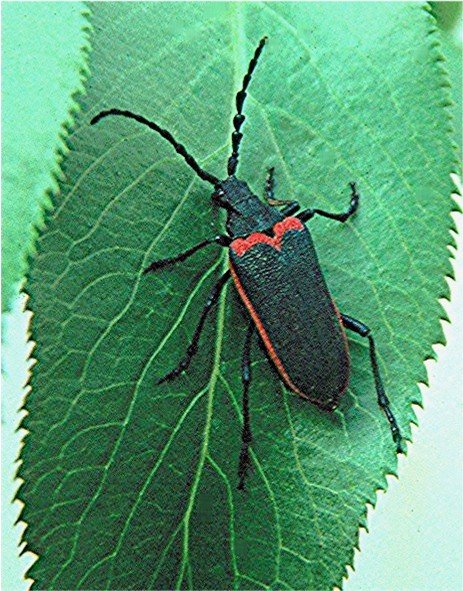|
Grammoptera Subargentata
''Grammoptera subargentata'' is a species of beetle in the family Cerambycidae The longhorn beetles (Cerambycidae), also known as long-horned or longicorns (whose larvae are often referred to as roundheaded borers), are a large family of beetles, with over 35,000 species described. Most species are characterized by anten .... It was described by William Kirby in 1837.Bezark, Larry G''A Photographic Catalog of the Cerambycidae of the World''. Retrieved 22 May 2012. References Lepturinae Beetles described in 1837 {{Lepturinae-stub ... [...More Info...] [...Related Items...] OR: [Wikipedia] [Google] [Baidu] |
Animalia
Animals are multicellular, eukaryotic organisms in the Biology, biological Kingdom (biology), kingdom Animalia (). With few exceptions, animals heterotroph, consume organic material, Cellular respiration#Aerobic respiration, breathe oxygen, have myocytes and are motility, able to move, can reproduce sexually, and grow from a hollow sphere of Cell (biology), cells, the blastula, during embryonic development. Animals form a clade, meaning that they arose from a single common ancestor. Over 1.5 million extant taxon, living animal species have been species description, described, of which around 1.05 million are insects, over 85,000 are molluscs, and around 65,000 are vertebrates. It has been estimated there are as many as 7.77 million animal species on Earth. Animal body lengths range from to . They have complex ecologies and biological interaction, interactions with each other and their environments, forming intricate food webs. The scientific study of animals is known as ... [...More Info...] [...Related Items...] OR: [Wikipedia] [Google] [Baidu] |
Arthropoda
Arthropods ( ) are invertebrates in the phylum Arthropoda. They possess an exoskeleton with a cuticle made of chitin, often mineralised with calcium carbonate, a body with differentiated ( metameric) segments, and paired jointed appendages. In order to keep growing, they must go through stages of moulting, a process by which they shed their exoskeleton to reveal a new one. They form an extremely diverse group of up to ten million species. Haemolymph is the analogue of blood for most arthropods. An arthropod has an open circulatory system, with a body cavity called a haemocoel through which haemolymph circulates to the interior organs. Like their exteriors, the internal organs of arthropods are generally built of repeated segments. They have ladder-like nervous systems, with paired ventral nerve cords running through all segments and forming paired ganglia in each segment. Their heads are formed by fusion of varying numbers of segments, and their brains are formed by fu ... [...More Info...] [...Related Items...] OR: [Wikipedia] [Google] [Baidu] |
Insecta
Insects (from Latin ') are hexapod invertebrates of the class Insecta. They are the largest group within the arthropod phylum. Insects have a chitinous exoskeleton, a three-part body (head, thorax and abdomen), three pairs of jointed legs, compound eyes, and a pair of antennae. Insects are the most diverse group of animals, with more than a million described species; they represent more than half of all animal species. The insect nervous system consists of a brain and a ventral nerve cord. Most insects reproduce by laying eggs. Insects breathe air through a system of paired openings along their sides, connected to small tubes that take air directly to the tissues. The blood therefore does not carry oxygen; it is only partly contained in vessels, and some circulates in an open hemocoel. Insect vision is mainly through their compound eyes, with additional small ocelli. Many insects can hear, using tympanal organs, which may be on the legs or other parts of the body ... [...More Info...] [...Related Items...] OR: [Wikipedia] [Google] [Baidu] |
Coleoptera
Beetles are insects that form the Taxonomic rank, order Coleoptera (), in the superorder Holometabola. Their front pair of wings are hardened into wing-cases, elytra, distinguishing them from most other insects. The Coleoptera, with about 400,000 described species, is the largest of all orders, constituting almost 40% of described arthropods and 25% of all known animal species; new species are discovered frequently, with estimates suggesting that there are between 0.9 and 2.1 million total species. However, the number of beetle species is challenged by the number of species in Fly, dipterans (flies) and hymenopterans (wasps). Found in almost every habitat except the sea and the polar regions, they interact with their ecosystems in several ways: beetles often feed on plants and fungi, break down animal and plant debris, and eat other invertebrates. Some species are serious agricultural pests, such as the Colorado potato beetle, while others such as Coccinellidae (ladybirds or ... [...More Info...] [...Related Items...] OR: [Wikipedia] [Google] [Baidu] |
Polyphaga
Polyphaga is the largest and most diverse suborder of beetles. It comprises 144 families in 16 superfamilies, and displays an enormous variety of specialization and adaptation, with over 350,000 described species, or approximately 90% of the beetle species discovered thus far. Key characteristics of Polyphaga are that the hind coxa (base of the leg) does not divide the first and second abdominal/ventral plates which are known as sternites. Also, the notopleural suture (found under the pronotal shield) is not present. Etymology The name of ''polyphaga'' is derived from two Greek words: , meaning 'many', and , meaning 'to eat', so the suborder is called the “eaters of many things”. Classification The five main infraorders are: * Bostrichiformia — including furniture beetles and skin beetles * Cucujiformia — includes lady beetles, longhorn beetles, weevils, checkered beetles and leaf beetles * Elateriformia — includes click beetle Elateridae or clic ... [...More Info...] [...Related Items...] OR: [Wikipedia] [Google] [Baidu] |
Cerambycidae
The longhorn beetles (Cerambycidae), also known as long-horned or longicorns (whose larvae are often referred to as roundheaded borers), are a large family of beetles, with over 35,000 species described. Most species are characterized by antennae as long as or longer than the beetle's body. A few species have short antennae (e.g., '' Neandra brunnea''), making them difficult to distinguish from related families such as Chrysomelidae. "Cerambycidae" comes from a Greek mythological figure: after an argument with nymphs, the shepherd Cerambus is transformed into a large beetle with horns. Longhorn beetles are found on all continents except Antarctica. Description Other than the typical long antennal length, the most consistently distinctive feature of adults of this family is that the antennal sockets are located on low tubercles on the face; other beetles with long antennae lack these tubercles, and cerambycids with short antennae still possess them. They otherwise vary great ... [...More Info...] [...Related Items...] OR: [Wikipedia] [Google] [Baidu] |
Grammoptera
''Grammoptera'' is a genus of beetles in the family Cerambycidae, distributed primarily in the Northern Hemisphere The Northern Hemisphere is the half of Earth that is north of the equator. For other planets in the Solar System, north is defined by humans as being in the same celestial sphere, celestial hemisphere relative to the invariable plane of the Solar .... List of species Source:Bezark, Larry GA Photographic Catalog of the Cerambycidae of the World. Retrieved on 22 May 2012. * '' Grammoptera abdominalis'' (Stephens, 1831) * '' Grammoptera andrei'' Holzschuh, 1999 * '' Grammoptera angustata'' Pic, 1892 * '' Grammoptera auricollis'' Mulsant & Rey, 1863 * '' Grammoptera baudii'' Sama, 1992 * '' Grammoptera bipustulata'' Steiner, 1975 * '' Grammoptera brezinai'' (Holzschuh, 1998) * '' Grammoptera cyanea'' Tamanuki, 1933 * '' Grammoptera coerulea'' Jureček, 1933 * '' Grammoptera debilipes'' (Holzschuh, 1991) * '' Grammoptera elongata'' Pic, 1941 * '' Grammoptera ex ... [...More Info...] [...Related Items...] OR: [Wikipedia] [Google] [Baidu] |
William Kirby (entomologist)
William Kirby (19 September 1759 – 4 July 1850) was an English entomologist, an original member of the Linnean Society and a Fellow of the Royal Society, as well as a country rector, so that he was an eminent example of the "parson-naturalist". The four-volume ''Introduction to Entomology'', co-written with William Spence (entomologist), William Spence, was widely influential. Family origins and early studies Kirby was a grandson of the Suffolk topographer John Kirby (topographer), John Kirby (author of ''The Suffolk Traveller'') and nephew of artist-topographer Joshua Kirby (a friend of Thomas Gainsborough's). He was also a cousin of the children's author Sarah Trimmer. His parents were William Kirby, a solicitor, and Lucy Meadows. He was born on 19 September 1759 at Witnesham, Suffolk, and studied at Ipswich School and Caius College, Cambridge, where he graduated in 1781. Taking holy orders in 1782, he spent his entire working life in the peaceful seclusion of an English ... [...More Info...] [...Related Items...] OR: [Wikipedia] [Google] [Baidu] |
John Richardson (naturalist)
Sir John Richardson Royal Society of London, FRS FRSE (5 November 1787 – 5 June 1865) was a Scotland, Scottish naval surgeon, natural history, naturalist and Arctic explorer. Life Richardson was born at Nith Place in Dumfries the son of Gabriel Richardson, Provost of Dumfries, and his wife, Anne Mundell. He was educated at Dumfries Grammar School. He was then apprenticed to his maternal uncle, Dr James Mundell, a surgeon in Dumfries. Richardson studied medicine at Edinburgh University, and became a surgeon in the navy in 1807. He traveled with John Franklin in search of the Northwest Passage on the Coppermine Expedition of 1819–1822. Richardson wrote the sections on geology, botany and ichthyology for the official account of the expedition. Franklin and Richardson Mackenzie River expedition, returned to Canada in 1825 and went overland by fur trade routes to the mouth of the Mackenzie River. Franklin was to go as far west as possible and Richardson was to go east to the mo ... [...More Info...] [...Related Items...] OR: [Wikipedia] [Google] [Baidu] |
Beetle
Beetles are insects that form the Taxonomic rank, order Coleoptera (), in the superorder Holometabola. Their front pair of wings are hardened into wing-cases, elytra, distinguishing them from most other insects. The Coleoptera, with about 400,000 described species, is the largest of all orders, constituting almost 40% of described arthropods and 25% of all known animal species; new species are discovered frequently, with estimates suggesting that there are between 0.9 and 2.1 million total species. However, the number of beetle species is challenged by the number of species in Fly, dipterans (flies) and hymenopterans (wasps). Found in almost every habitat except the sea and the polar regions, they interact with their ecosystems in several ways: beetles often feed on plants and fungi, break down animal and plant debris, and eat other invertebrates. Some species are serious agricultural pests, such as the Colorado potato beetle, while others such as Coccinellidae (ladybirds or ... [...More Info...] [...Related Items...] OR: [Wikipedia] [Google] [Baidu] |
Lepturinae
Lepturinae, the lepturine beetles, is a subfamily of the longhorn beetle family (biology), family (Cerambycidae), containing about 150 genera worldwide. This lineage is most diverse in the Northern Hemisphere. Until recently the subfamily Necydalinae was included within the lepturines, but this has been recently recognized as a separate subfamily. Nine tribes are usually recognized today, with a tenth, Caraphiini, created in 2016. A few genera are of uncertain placement within the subfamily. Usually among the smaller members of their family, these beetles are of a slender shape – particularly the Thorax (insect anatomy), thorax is markedly less wide than the wings, while the elytra tips are often pointed. They differ from most other longhorn beetles in that the antenna (biology), antennae are not directly adjacent to the compound eyes. Hence, the latter are generally oval in outline, rather than having an indentation where the antennae originate, or even being divided by t ... [...More Info...] [...Related Items...] OR: [Wikipedia] [Google] [Baidu] |







